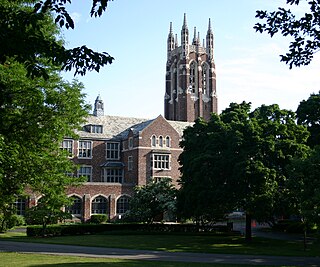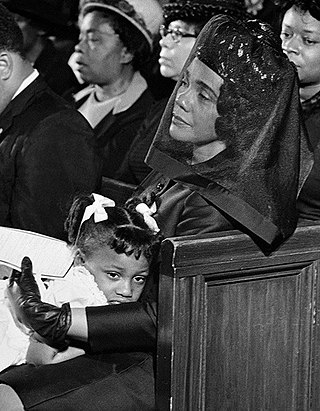
Martin Luther King Jr. was an American Baptist minister, activist, and political philosopher who was one of the most prominent leaders in the civil rights movement from 1955 until his assassination in 1968. A Black church leader and a son of early civil rights activist and minister Martin Luther King Sr., King advanced civil rights for people of color in the United States through nonviolence and civil disobedience. Inspired by his Christian beliefs and the nonviolent activism of Mahatma Gandhi, he led targeted, nonviolent resistance against Jim Crow laws and other forms of discrimination in the United States.

Martin Luther King Sr. was an African-American Baptist pastor, missionary, and an early figure in the Civil Rights Movement. He was the father and namesake of the civil rights leader Martin Luther King Jr. He was the senior pastor of Atlanta's Ebenezer Baptist Church from 1931 to 1975.

Alberta Christine Williams King was an American civil rights organizer best known as the mother of Martin Luther King Jr., and as the wife of Martin Luther King Sr. She was the choir director of the Ebenezer Baptist Church. She was shot and killed in the church by 23-year-old Marcus Wayne Chenault six years after the assassination of her eldest son Martin Luther King Jr.
Wyatt Tee Walker was an African-American pastor, national civil rights leader, theologian, and cultural historian. He was a chief of staff for Martin Luther King Jr., and in 1958 became an early board member of the Southern Christian Leadership Conference (SCLC). He helped found a Congress for Racial Equality (CORE) chapter in 1958. As executive director of the SCLC from 1960 to 1964, Walker helped to bring the group to national prominence. Walker sat at the feet of his mentor, BG Crawley, who was a Baptist Minister in Brooklyn, NY and New York State Judge.

Colgate Rochester Crozer Divinity School is a Baptist seminary in Rochester, New York It is affiliated with the American Baptist Churches USA.
Eddie Lee Long was an American pastor who served as the senior pastor of New Birth Missionary Baptist Church, a megachurch in unincorporated DeKalb County, Georgia, from 1987 until his death in 2017.
Religion in Atlanta, while historically centered on Protestant Christianity, now involves many faiths as a result of the city and metro area's increasingly international population. While Protestant Christianity still maintains a strong presence in the city, in recent decades Catholic Christians have gained a strong foothold due to migration patterns. Atlanta also has a considerable number of ethnic Christian congregations, such as Korean Baptist, Methodist, and Presbyterian Churches, the Tamil Church Atlanta, Telugu Church, Hindi Church, Malayalam Church, Ethiopian, Chinese, and many more traditional ethnic religious groups. Large non-Christian faiths are present in the form of Buddhism, Judaism and Hinduism. Overall, there are over 1,000 places of worship within Atlanta.

The First Baptist Church on North Ripley Street in Montgomery, Alabama, is a historic landmark. Founded in downtown Montgomery in 1867 as one of the first black churches in the area, it provided an alternative to the second-class treatment and discrimination African-Americans faced at the other First Baptist Church in the city.

The first memorial service following the assassination of Martin Luther King Jr. on April 4, 1968, took place the following day at the R.S. Lewis Funeral Home in Memphis, Tennessee. This was followed by two funeral services on April 9, 1968, in Atlanta, Georgia, the first held for family and close friends at Ebenezer Baptist Church, where King and his father had both served as senior pastors, followed by a three-mile procession to Morehouse College, King's alma mater, for a public service.
The Reverend Horatius Holipheal Coleman, better known as H. H. Coleman, was an American church pastor and evangelist. Reverend Coleman, who was born in Decatur, Georgia, was senior pastor of Greater Macedonia Baptist Church in Detroit, Michigan, from 1935 until his death in 1969. He was the paternal great-grandfather of former U.S. Representative Kendrick B. Meek, and the maternal grandfather of actress Barbara Meek.
William Holmes Borders Sr. was an American civil rights activist and leader and pastor of Wheat Street Baptist Church in Atlanta, Georgia from 1937 to 1988.

Ebenezer Baptist Church is a Baptist megachurch located in Atlanta, Georgia, United States, affiliated with the Progressive National Baptist Convention and American Baptist Churches USA. It was the church where Dr. Martin Luther King Jr. was co-pastor from 1960 until his assassination in 1968, the location of the funerals of both Dr. King and congressman John Lewis, and the church for which United States Senator Raphael Warnock has been pastor since 2005. It is located in the historic area now designated as the Martin Luther King Jr. National Historical Park.

Reverend Doctor Henry G. Elkins Jr. is best known for his early work in the civil rights movement. In the early 1960s Elkins served as assistant pastor to Martin Luther King Jr. at Ebenezer Baptist Church. He lived with the King family and helped lead civil rights activities. In the early 1970s Elkins switched career paths and became an American Public Health and International Development scholar at Columbia University and then worked with the Population Council and USAID.

Joseph W. Ellwanger Jr. is a Lutheran pastor, author, and civil rights activist. He was a key figure in the Civil Rights Movement in Birmingham, Alabama, and the only white religious leader included in strategy meetings with Martin Luther King Jr.
Josephus Pius Barbour was an American Baptist pastor of Calvary Baptist Church in Chester, Pennsylvania who served as an executive director of the National Baptist Association, editor of the National Baptist Voice publication. The first African American to graduate from Crozer Theological Seminary in 1937, he later mentored a teenaged Martin Luther King Jr., when King was a student there.

The Lutheran Church of the Redeemer is a Lutheran church in midtown Atlanta, Georgia. The congregation was founded in the city in 1903, with the current building constructed in 1952.
The Atlanta washerwomen strike of 1881 was a labor strike in Atlanta, Georgia involving African American washerwomen. It began on July 19, 1881, and lasted into August 1881. The strike began as an effort to establish better pay, more respect and autonomy, and a uniform base salary for their work.
South-View Cemetery is a historic African-American-founded cemetery located approximately 15 minutes from downtown Atlanta, Georgia. An active operational cemetery on over 100 acres of land, it is the oldest African-American cemetery in Atlanta, Georgia and the oldest African-American “non eleemosynary” corporation in the country. Founded in 1886, it has since served as the burial place for many leaders in the civil rights movement including Julian Bond and John Lewis. Martin Luther King Jr. was originally buried here but was later moved to the King National Historic Park in Atlanta.

Behold is a statue designed by sculptor Patrick Morelli. Dedicated in 1990 by Coretta Scott King, the statue is located in front of Ebenezer Baptist Church, in the Martin Luther King Jr. National Historical Park.
The Atlanta sit-ins were a series of sit-ins that took place in Atlanta, Georgia, United States. Occurring during the sit-in movement of the larger civil rights movement, the sit-ins were organized by the Committee on Appeal for Human Rights, which consisted of students from the Atlanta University Center. The sit-ins were inspired by the Greensboro sit-ins, which had started a month earlier in Greensboro, North Carolina with the goal of desegregating the lunch counters in the city. The Atlanta protests lasted for almost a year before an agreement was made to desegregate the lunch counters in the city.














